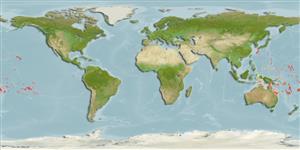Preferred temperature (Ref.
123201): 24.9 - 29.4, mean 28 °C (based on 866 cells).
Phylogenetic diversity index (Ref.
82804): PD
50 = 1.0000 [Uniqueness, from 0.5 = low to 2.0 = high].
Bayesian length-weight: a=0.01698 (0.00966 - 0.02985), b=3.02 (2.87 - 3.17), in cm total length, based on LWR estimates for this species & (Sub)family-body (Ref.
93245).
Trophic level (Ref.
69278): 2.9 ±0.36 se; based on food items.
Widerstandsfähigkeit (Ref.
120179): mittel, Verdopplung der Population dauert 1,4 - 4,4 Jahre. (Preliminary K or Fecundity.).
Fishing Vulnerability (Ref.
59153): Moderate vulnerability (42 of 100).
Nutrients (Ref.
124155): Calcium = 56.5 [21.4, 162.2] mg/100g; Iron = 0.583 [0.267, 1.446] mg/100g; Protein = 19.2 [17.3, 21.0] %; Omega3 = 0.164 [0.079, 0.352] g/100g; Selenium = 20.2 [10.1, 46.8] μg/100g; VitaminA = 76.9 [18.4, 318.1] μg/100g; Zinc = 1.67 [1.08, 2.59] mg/100g (wet weight);
